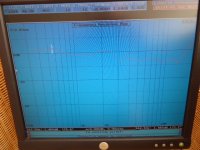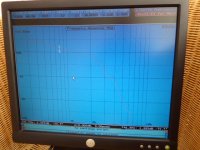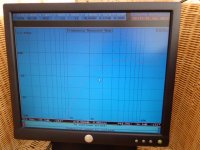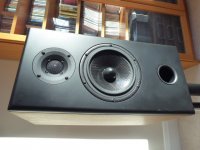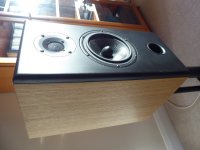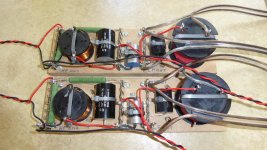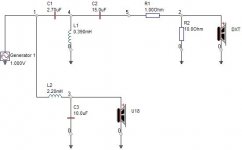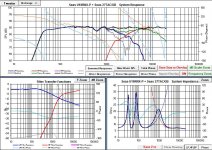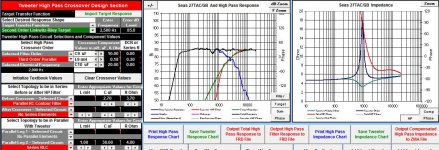Sorry for bringing up this old topic. But I recently built the Idunn as I don't have much time to design a speaker from scratch. I did some basic testing with an old Liberty Audio suite which seemed to correlate that the speaker, as good as it is, has something wrong with it. Contrary to what other have said the speaker has a very extended bass with excellent detail and level. The problem is that it sounds too forward making solo piano sound "chrome plated" on the higher notes. However cymbals sound a touch too low in level. I have done some very quick changes by adding an extra amount of bass inductance (externally) but the hump remains. Any ideas what is wrong please?
Attachments
Last edited:
What puzzles me is where is the extra energy coming from at 2K. The individual responses seem to be quite down at that frequency.
I don't think you are going to get a lot of extreme top end off this tweeter:
H1499-06 27TBCD/GB-DXT
The woofer is tidy enough:
H1571-08 U18RNX/P
You probably need to add a supertweeter for cymbals:
SP38/13
Not the easiest fix. Bit of a redesign.
H1499-06 27TBCD/GB-DXT
The woofer is tidy enough:
H1571-08 U18RNX/P
You probably need to add a supertweeter for cymbals:
SP38/13
Not the easiest fix. Bit of a redesign.
Hi Steve Thanks for your reply. Yes the DXT series dropper resistor is just 1 Ohm so I'm not going to get much more out of it even by driving it directly....The only way will be to start completely from scratch and do a total new design. I am sure the U18 is an excellent driver but the whole design needs redoing. Unfortunately I have massive amounts of other DIY jobs that have to be done.
I think the DXT must be a good tweeter. Joachim Gerhard, who is no slouch, say it works well on a simple 3.3uF or 4.7uF capacitor with a bit of level adjust via a resistor. But it clearly rolls off at the top. This can be a soothing sound.
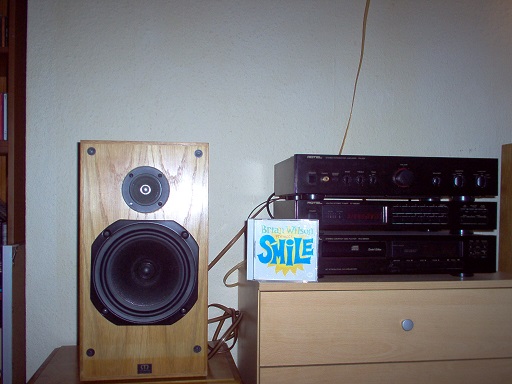
You've probably ended up in the same place as me with a cone tweeter. I'd suggest you try to point the axis at your ears.
You've probably ended up in the same place as me with a cone tweeter. I'd suggest you try to point the axis at your ears.
Just a thought if you want to try an easy fix, the U18 works well enough on a mere coil. You might lose the bass shunt capacitor too. No idea how phase works without modelling it, but what's to lose?
Your individual unit measurements equal those from Seas. Look at the off axis response and you see the response rise for about 4dB, which is quite equal to your measurement.
I'd say (and I say this more often) this all is caused by a less than perfect baffle step correction with the single big coil. The directivity vs. frequency isn't what it could be. Bettering it requires redesigning the crossover.
I'd say (and I say this more often) this all is caused by a less than perfect baffle step correction with the single big coil. The directivity vs. frequency isn't what it could be. Bettering it requires redesigning the crossover.
It's amazing how simple you can get with 6" polycone bass.
This was the Monitor Audio design which seemed to please people:
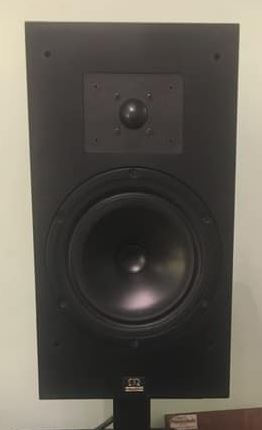
Crossover is not rocket science:
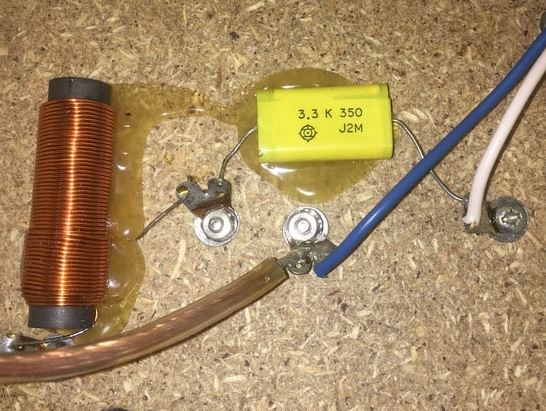
As I say, no idea what polarity might be.
This was the Monitor Audio design which seemed to please people:
Crossover is not rocket science:
As I say, no idea what polarity might be.
Last edited:
It's not the tweeter.
I built the Bragi kit (same tweeter).
Auditioned the Kii speaker last friday (a 13k € hi-end system...yes that expensive with a 60 € tweeter...).
I'd say the tweeter puts out too less; did you check crossover schematic/wiring?
I built the Bragi kit (same tweeter).
Auditioned the Kii speaker last friday (a 13k € hi-end system...yes that expensive with a 60 € tweeter...).
I'd say the tweeter puts out too less; did you check crossover schematic/wiring?
Last edited:
Thanks for your suggestions Steve.. In the past with other designs I created I found that just fiddling around probably takes longer than to start afresh so this is what I might do.
Thank you markbakk. yes you are right, when I look closer at the Seas official plots they are indeed very similar especially when you consider that i did not spend that much time in setting up the microphone and placement. In fact with more care I reckon the plots would be identical. It is odd though that the SEAS plots do not show the big rise after 15K Hz like my ones do.
As daanve suggests ..I thought the same thing about the low level of the tweeter and maybe I have built the crossover wrong but I have checked it many times and measured all the components too. Also the impedance plot follows the SEAS design exactly. It makes me wonder if the tweeters are faulty but very unlikely as they both measure identically. It is strange.
Please note the cabinets are shorter but they are deeper to maintain approx 20L. The position of the tweeter and woofer in relation to the box edges are EXACTLY as specified. It is only at the bottom that there is a change which I am sure makes no difference at all.
Thank you markbakk. yes you are right, when I look closer at the Seas official plots they are indeed very similar especially when you consider that i did not spend that much time in setting up the microphone and placement. In fact with more care I reckon the plots would be identical. It is odd though that the SEAS plots do not show the big rise after 15K Hz like my ones do.
As daanve suggests ..I thought the same thing about the low level of the tweeter and maybe I have built the crossover wrong but I have checked it many times and measured all the components too. Also the impedance plot follows the SEAS design exactly. It makes me wonder if the tweeters are faulty but very unlikely as they both measure identically. It is strange.
Please note the cabinets are shorter but they are deeper to maintain approx 20L. The position of the tweeter and woofer in relation to the box edges are EXACTLY as specified. It is only at the bottom that there is a change which I am sure makes no difference at all.
Attachments
Last edited:
Yes, correct.
Honestly I rebuilt the crossovers for the Bragi kit as the originals did not do very well.
I ended up with a 2,5 way.
Honestly I rebuilt the crossovers for the Bragi kit as the originals did not do very well.
I ended up with a 2,5 way.
Are drivers in-phase across the whole crossover region when the tweeter is connected with inverse polarity?
Hi tuantran ... many thanks for getting in touch, yes that is the correct crossover.
As regards the reverse polarity, I did not do this test as I was under pressure to tidy up the living room. The Liberty Audio Suite is antiquated and needs an old Windows 98 desktop PC and loads of other boxes and cables....Once I saw the frequency response I packed up the test gear, sighed deeply, and made plans to spend lots of time at some point to start the whole build again. However I have to say with well recorded orchestral music the speakers can sound excellent and quite smooth with massive amounts of subtle detail and ambience. It seems that this speaker has been made by lots of people worldwide yet no-one has ever posted a better design of crossover even though many have made criticisms of it often with opposing verdicts. Summing up I would say it can sound very good indeed but I AM sure it can be made even better (near perfect) with just some changes which at the moment I have not the amount of time to really do it myself. Thanks again
As regards the reverse polarity, I did not do this test as I was under pressure to tidy up the living room. The Liberty Audio Suite is antiquated and needs an old Windows 98 desktop PC and loads of other boxes and cables....Once I saw the frequency response I packed up the test gear, sighed deeply, and made plans to spend lots of time at some point to start the whole build again. However I have to say with well recorded orchestral music the speakers can sound excellent and quite smooth with massive amounts of subtle detail and ambience. It seems that this speaker has been made by lots of people worldwide yet no-one has ever posted a better design of crossover even though many have made criticisms of it often with opposing verdicts. Summing up I would say it can sound very good indeed but I AM sure it can be made even better (near perfect) with just some changes which at the moment I have not the amount of time to really do it myself. Thanks again
It looks like the crossover point is 2khz, so it shouldn't be too hard to drop the level at that point.
I'd increase the value of C3 and decrease the value of C1. Parallel something like a 2.2uf across C3 to make 12.2uf, and replace C1 with a 2.2uf.
I'd increase the value of C3 and decrease the value of C1. Parallel something like a 2.2uf across C3 to make 12.2uf, and replace C1 with a 2.2uf.
it looks to me that some seas kits do not have the best crossovers, i recently tried their crossover for the t18 coaxial driver and it was not good
it looks like this crossover can be improved too
it looks like this crossover can be improved too
Hi fatmarley. Not far off..Seas says the x-over point is 2.2K and thanks for the suggestions of how to drop the hump down a bit. Looking at the shape of the tweeter response I reckon the best place to start would be to get that knee or kink removed at 2.5K where it flatlines for a bit before rising again at 3.5K. once the shape of the HF is smooth and falls away with a smooth slope the LF sectioned can be tuned in to it level wise, to sum together with a flat output and maybe it would not need much alteration for it to match. As markbakk said earlier though, the single large inductor is probably creating some unevenness further back though. I was thinking if I have time I will try to measure the individual responses without a crossover and put the response and impedance files on this forum so someone could have a go at creating a flat response by simulation and I would make it and see how it works in practice
Dropping the tweeter at 2k is a wise suggestion. That way the sound power response wil even out (the DXT horn doesn't do anything at 2k) and the listening experience will benefit at the cost of a less linear on axis response.
Furthermore the baffle step correction with only the large inductor does often take away too much at 500Hz-1kHz. At least with rather small baffles like this one. With 2m2 I'd say this could be the case. A dedicated notch network to take away the baffle step from 1k upwards, combined with a normal crossover setup, could be beneficial.
Furthermore the baffle step correction with only the large inductor does often take away too much at 500Hz-1kHz. At least with rather small baffles like this one. With 2m2 I'd say this could be the case. A dedicated notch network to take away the baffle step from 1k upwards, combined with a normal crossover setup, could be beneficial.
On a Norwegian forum there was a guy who used Mark K's design with a minor tweak on the crossover to accomodate the U18 instead of the ER18.
He used 2.2mH and 66ohm instead of 2.5mH and 60ohm. The rest of the crossover he kept original to Mark K's.
I have actually thought of trying this for my self as well.
ER18DXT: Overview
He used 2.2mH and 66ohm instead of 2.5mH and 60ohm. The rest of the crossover he kept original to Mark K's.
I have actually thought of trying this for my self as well.
ER18DXT: Overview
- Home
- Loudspeakers
- Multi-Way
- Seas Idunn Crossover.
